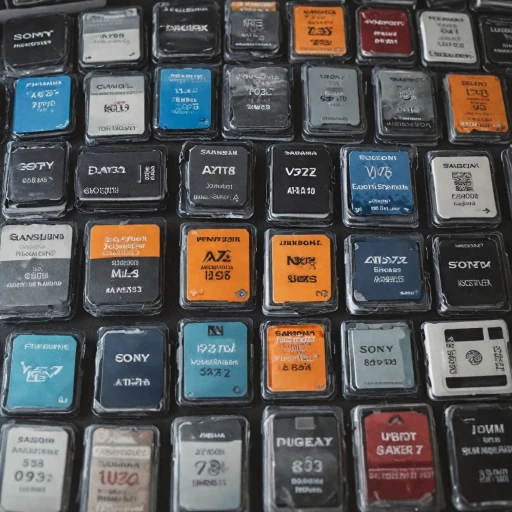Understanding Memory Card Types
An Introduction to the Essentials of Memory Cards
When it comes to choosing a memory card for your digital camera, understanding the different types available is crucial. Memory cards, such as CFexpress and UHS, are specifically designed to store images and videos, each offering unique advantages suited to different shooting needs.
CFexpress Cards are known for their fast write speeds and are often favored by professionals who require high-speed continuous shooting and recording of high-resolution video. These cards utilize the express standard to deliver impressive performance, making them ideal for high-end cameras that demand quick data transfer rates.
UHS Cards (Ultra High Speed) are another popular option, particularly among enthusiasts and semi-professional photographers. While not as fast as CFexpress, UHS cards provide adequate speed classes for many modern cameras, allowing for efficient burst shooting and speedy image transfers.
The decision between CFexpress and UHS, as well as considerations around capacity and cost, can significantly impact the efficiency and convenience of your shoot. Understanding these differences will aid in making an informed choice, ensuring your camera’s buffer performs well for your specific needs.
Speed and Performance Comparison
Decoding Speed and Performance Differences
When it comes to digital photography and videography, the speed and performance of your memory card play a crucial role in ensuring seamless shooting experiences. With the advent of high resolution images and ultra-high-definition video, cards like CFexpress and UHS have become increasingly sought after for their superior speed capabilities. CFexpress cards, in particular, are known for their high speed performance, supporting read and write speeds that cater to professionals engaging in burst shooting or shooting high-end video.
CFexpress cards push the boundaries with their express card capabilities, designed to handle large amounts of data with minimal delay. This is crucial when you're shooting high resolution photographs or 4K video, where the lag in data transfer can greatly affect the quality and efficiency of your work. On the other hand, UHS cards, while slightly less expensive than CFexpress, offer impressive speed classes suitable for less demanding tasks.
Another notable advantage of CFexpress is the buffer handling during continuous shooting. Cameras equipped with CFexpress card support can manage longer sequences without downtime, making them ideal for action photography or extensive event coverage. In contrast, UHS cards may face limitations when users push the camera’s buffer with extended burst rates.
It’s important to note that the choice between CFexpress and UHS may also depend on the type card reader you have. A compatible card reader enhances the overall efficiency by ensuring that data is transferred swiftly and reliably to your editing suite or storage devices. Choosing the best memory cards for your Sony A7V can illustrate how specific camera models align with these card types, aiding in making an informed decision.
Capacity and Storage Options
Evaluating the Storage Options
When selecting a memory card for your digital camera, evaluating the capacity and storage options is crucial. Both CFexpress and UHS cards present a range of benefits depending on shooting requirements and preferences. CFexpress cards offer substantial storage capacities that cater to photographers who shoot high resolution images and 4K or even 8K video. This high capacity is particularly advantageous for professionals involved in burst shooting or long-duration video recording sessions, ensuring they don’t need to frequently switch cards. However, the large storage comes with a high price tag, making these cards more of an investment. On the other hand, UHS cards are generally more affordable and widely available in various capacities. While they may not match CFexpress cards in terms of capacity or speed, they provide ample storage for photographers who mainly indulge in still photography or standard video shooting. With advancements in UHS card technology, many options now offer high-speed writing capabilities that make them competitive for day-to-day professional needs. For some photographers, the decision might also hinge on whether their camera model supports dual slot usage. Many cameras feature a CFexpress or XQD slot alongside a UHS slot, allowing users to utilize both card types simultaneously. This setup not only provides flexibility in capacity but also offers a cost-effective solution for backing up images and videos.Explore more about choosing the best memory cards for your Sony A7V where balancing speed and capacity is thoroughly discussed. The choice between CFexpress and UHS type cards often boils down to balancing the specific needs for speed classes and storage capacities with one's budget. For those who shoot high volumes of images or need high-speed video capture, having a robust storage option is a wise investment.Cost Considerations
Financial Investment and Affordability
When diving into the realm of memory card choices for your digital camera, cost is a significant factor that can sway your decision. The choice between CFexpress and UHS cards doesn't just hinge on speed and capacity, but also on your budget and how much you're willing to invest in your photography gear. CFexpress cards are often positioned at the higher end of the price spectrum. The reason behind this primarily lies in their advanced technology. These cards offer remarkable speed and performance, especially beneficial for high-resolution video recording and burst shooting. However, this technological edge comes with a heftier price tag. Investing in CFexpress means you're committing to a high-performance option that will likely provide an advantage in more demanding shooting environments. Conversely, UHS cards, while offering generally slower write speeds and limited performance in comparison, tend to be more budget-friendly. They're often adequate for entry to mid-level camera models and are a suitable option if you're shooting less demanding content or working with lower-memory-intensive photography like day-to-day casual shooting or standard video recording. Consider a balance between cost and utility – if you're a professional photographer or videographer dealing with high-speed requirements or large image files, the investment in CFexpress might be justified. However, for everyday consumers or hobbyists, UHS cards could provide the best balance of performance and expense. Ultimately, understanding the cost disparity helps in making an informed choice, ensuring that your digital camera setup aligns both with your financial scope and your shooting needs.Compatibility with Camera Models
Assessing Camera Compatibility with Memory Cards
When selecting between CFexpress and UHS cards for your digital camera, understanding compatibility is crucial. Not all cameras support both card types, so it's essential to check your camera's specifications and compatibility documents. Many recent high-end cameras offer dual card slots, allowing for a combination of different types such as CFexpress and UHS cards. This can provide flexibility, especially if you're shooting high resolution videos or images that demand high speed write capabilities.
CFexpress cards, known for their impressive speed, often supersede the speed classes offered by UHS cards. However, this does not diminish the efficiency of UHS cards in supported cameras, especially for amateur photographers who may not need high speed continuous burst shooting. Some cameras support older formats like XQD or CFexpress Type B, which means you'll need to check your specific model to determine which cards are compatible.
Investing in a compatible card reader is equally important. Having the right reader, such as those offered by ProGrade Digital, ensures that transferring images and videos from the memory card to your computer is swift and seamless. An incompatible or slower reader could negate the benefits of using faster cards.
Remember that compatibility also involves considering firmware updates, which can enhance or broaden the list of supported card types for your camera model. Staying informed on manufacturers' updates can help future-proof your investment in memory cards. Ensuring your camera can efficiently handle the memory cards you choose will keep your focus on capturing the perfect shot without concern over card performance.
Future-Proofing Your Investment
Planning for Future Camera Needs
When choosing between CFexpress and UHS memory cards, it's crucial to consider how your choice will impact future-proofing your camera equipment. As technology continues to advance, ensuring your camera can keep pace with evolving demands is essential.- Emerging Technologies: CFexpress cards represent the pinnacle of high-speed performance, capable of handling the most demanding tasks like burst shooting and high-resolution video. If you're planning to invest in a new camera model, especially those with dual slot configurations, opting for CFexpress might be a wise choice due to its high-speed capabilities and expanding usage across new camera lines.
- Compatibility with Future Cameras: Consider whether your chosen card type will be widely supported in upcoming camera releases. Cameras integrating CFexpress XQD slots are increasingly releasing firmware updates to support CFexpress, signaling a possible shift towards these cards in the future. In contrast, UHS cards, though still prevalent, might not offer the same advancement in speed and technology.
- Long-Term Value: While CFexpress cards can be more expensive initially, their ability to handle extensive data loads and high-speed write rates offers long-term value for professional photographers and videographers who regularly shoot in high resolution. Prograde Digital's latest offerings in CFexpress cards, for instance, feature robust durability and enhanced performance, making them a sound investment for the future.
- Access to Peripherals: Investing in the appropriate card reader is another consideration for future-proofing. Current CFexpress card readers provide swift data transfer rates, crucial for professional workflows that require quick turnaround times from shoot to editing.




